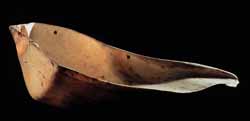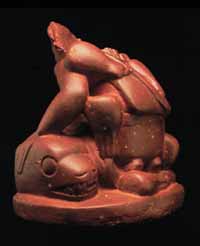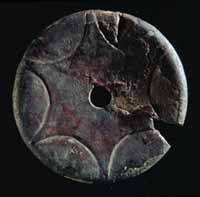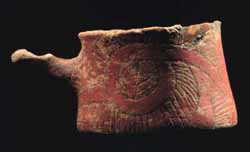
 |
Conch shell (Busycon) dipper, unknown source. | |
|
Marine shell, such as the example illustrated here, and a variety of other materials were obtained from distant locations through trade. The city of Cahokia was a Mississippian marketplace where one might obtain marine shell, different types of stone for making arrowpoints or woodworking tools, or finished goods like Mill Creek chert hoes from Union County, Illinois. In the marketplace, one might have exchanged white-tailed deer hides or beaver pelts for marine shell or another exotic good. |
||
Mississippian trade involved much more than material and objects. It appears that ideas were also widely exchanged.
By this time, Native Americans had been involved in long- distance trade for at least 3,000 years, and Mississippian people continued to exchange material and objects with distant communities. For example, Mississippians living along Mill Creek in Union County used high-quality stone found along the creek to make hoes for farming. These hoes were traded throughout Illinois and the Midwest.
Mississippians made cups, gorgets, beads, and other ornaments of marine shell such as whelks (Busycon)found in the Atlantic Ocean and Gulf of Mexico.
 |
Birger figurine, BBB Motor site, Madison County. | |
|
Artisans in the American Bottom, a stretch of Mississippi River flood plain around East St. Louis, used. |
||
They used Missouri flint clay to make large pipes and statues. This soft stone could be carved and finished with harder stones. In this image, we see a woman with a hoe in her hand kneeling over the back of a serpent.
 |
Copper-covered earspool, Greene County. |
Like their Archaic and Woodland ancestors, Mississippian people continued to acquire copper from the Great Lakes region. They pounded copper nuggets into flat sheets. In this example, a thin sheet of copper with an embossed sun symbol was applied onto an earspool.
 |
Engraved Mississippian bean pot, Frazier site, Fulton County. | |
|
Abstract symbols such as the ones illustrated here adorned many objects including pottery jars and marine shell. This pot was also decorated with a red slip, a mixture of liquid clay and an iron-rich pigment, which was painted on the exterior of the vessel. |
||
Archaeologists also have found evidence that ideas, often in the form of specific designs found on pottery or engraved into marine shell, were widely distributed during Mississippian times. Abstract images of forked eyes, hand and eye motifs, birds of prey, sun symbols, and the circle and cross are found throughout the country east of the Mississippi River and west to the Spiro site in Oklahoma.
|
|
Copyright © 2000 Illinois State Museum